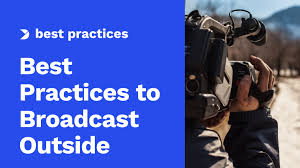Outdoor broadcasting has become increasingly popular as event organizers seek to reach broader audiences through live streaming. Whether you’re broadcasting a concert, sports event, or community gathering, successful outdoor broadcasting requires careful planning, the right equipment, and effective techniques. This guide will provide you with essential tips and insights to ensure your outdoor broadcasting endeavors are smooth and successful.
Understanding Outdoor Broadcasting
1. What is Outdoor Broadcasting?
Outdoor broadcasting refers to the process of transmitting live audio and video content from outdoor locations to an audience, often using digital platforms. This practice enables viewers who cannot attend the event physically to experience it in real time. As technology advances, outdoor broadcasting has become more accessible, allowing organizations of all sizes to engage with larger audiences.
2. Why Outdoor Broadcasting Matters
With the rise of social media and streaming platforms, outdoor broadcasting allows for wider reach and engagement. It not only enhances event visibility but also provides opportunities for sponsorship and advertising. Furthermore, outdoor broadcasting enables event organizers to create lasting memories for participants and viewers alike, fostering a sense of community.
Essential Gear for Outdoor Broadcasting
1. Video Cameras
High-quality video cameras are crucial for capturing stunning visuals during outdoor broadcasts. Look for cameras that offer 4K resolution, good low-light performance, and weather resistance. Depending on your budget and needs, options range from professional camcorders to high-end DSLRs or mirrorless cameras. Ensure that your cameras have sufficient battery life and storage to last through the event.
2. Audio Equipment
Clear audio is vital for engaging broadcasts. Invest in quality microphones, such as lavalier mics for interviews or shotgun mics for capturing ambient sound. Additionally, consider using audio mixers to balance sound levels effectively. If broadcasting live music, ensure you have the appropriate gear to capture the performance accurately.
3. Streaming Devices
A reliable streaming device is essential for broadcasting content online. Consider devices like encoders or hardware solutions that can connect directly to the internet, allowing for seamless streaming. Ensure that the device you choose supports your desired streaming platforms, such as YouTube or Facebook Live.
4. Lighting Solutions
Outdoor lighting can be unpredictable, especially during evening events. Portable LED lights can help enhance visibility and improve video quality. Use diffusers to soften harsh lighting and prevent unflattering shadows. Planning for variable lighting conditions ensures that your broadcast remains visually appealing.
5. Cables and Connectors
A successful outdoor broadcast relies on the proper cables and connectors. Invest in high-quality, durable cables that can withstand outdoor conditions. Have backup cables available to prevent technical difficulties during the event. Consider using cable management tools to keep your setup organized and safe.
Pre-Event Preparation
1. Site Assessment
Before the event, conduct a thorough site assessment to determine the best locations for camera placement, audio capture, and broadcasting equipment. Assess factors such as lighting, access to power sources, and potential obstacles that may affect visibility or sound quality. Understanding the environment will help you plan effectively.
2. Test Your Gear
Prior to the event, test all your equipment to ensure everything functions correctly. Check video and audio quality, battery life, and internet connectivity. Conducting thorough tests will help identify potential issues and allow you to make necessary adjustments before going live.
3. Plan Your Content
Create a detailed plan outlining the event’s schedule, including key moments you want to capture. Coordinate with speakers, performers, and hosts to ensure everyone is on the same page. Preparing a content plan will help keep your broadcast organized and focused.
Techniques for Effective Outdoor Broadcasting
1. Engage Your Audience
Engagement is key to successful outdoor broadcasting. Encourage viewer interaction through social media platforms, allowing them to ask questions and share comments during the live stream. Incorporating viewer feedback can enhance the experience and foster a sense of community.
2. Utilize Multiple Camera Angles
Using multiple cameras can create a dynamic viewing experience. Position cameras at different angles to capture various perspectives of the event. Switching between angles during the broadcast adds visual interest and keeps the audience engaged.
3. Implement Graphics and Overlays
Graphics and overlays can enhance your broadcast by providing additional information, such as event schedules, sponsor logos, and social media handles. These elements help to maintain viewer interest and reinforce branding. Ensure that your graphics are visually appealing and do not distract from the content.
4. Monitor Your Broadcast
During the event, appoint someone to monitor the broadcast in real time. This person can check for audio and video quality, respond to viewer comments, and manage any technical issues that may arise. Having a dedicated team member ensures that your broadcast runs smoothly.
Post-Event Follow-Up
1. Review Your Broadcast
After the event, take the time to review your broadcast. Analyze the video and audio quality, audience engagement, and any technical difficulties encountered. Gathering feedback from your team and viewers can provide valuable insights for future broadcasts.
2. Promote the Recorded Content
If the event was recorded, promote the content on various platforms. Sharing highlights or full recordings allows you to reach a broader audience, engage with viewers who missed the live event, and maintain momentum for future events.
3. Plan for Future Events
Use the lessons learned from your outdoor broadcasting experience to inform your future plans. Identify areas for improvement, consider new techniques, and invest in any additional gear that could enhance your next broadcast. Continuous improvement will lead to more successful outdoor broadcasting experiences.
Conclusion
Outdoor broadcasting offers exciting opportunities to connect with wider audiences and elevate event experiences. By understanding the importance of preparation, utilizing the right gear, and employing effective techniques, you can create successful live broadcasts that resonate with viewers. Remember to engage with your audience and continuously improve your skills for the best outcomes. With the right approach, outdoor broadcasting can be a rewarding endeavor for both you and your viewers.
Are you passionate about sharing your insights and expertise? We invite you to write for us! Whether you’re a seasoned writer or just starting out. We’re looking for fresh perspectives on a variety of topics, from lifestyle and wellness to technology and travel.
 Lifeyet News Lifeyet News
Lifeyet News Lifeyet News





